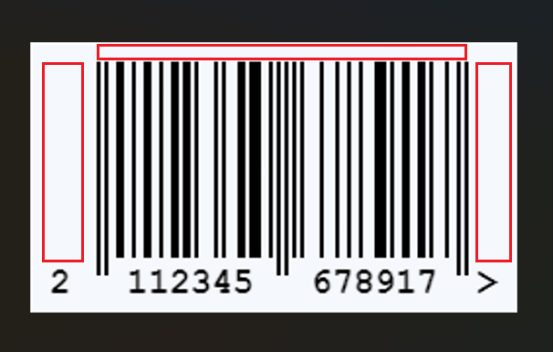In the world of barcodes, one key element that ensures the reliability and accuracy of barcode scanning is the barcode quiet zone. This guide explores what a barcode quiet zone is, why it is essential, and the specific requirements for maintaining an effective quiet zone.
What is a Barcode Quiet Zone?
A barcode quiet zone is a clear, unprinted area surrounding a barcode. This zone, also known as the "clear area"or "light margin" is devoid of any text, graphics, or markings that could interfere with the scanning process.
The quiet zone helps the barcode scanner differentiate the barcode from other elements, ensuring accurate data capture.

Importance of the Barcode Quiet Zone
The barcode quiet zone is crucial for several reasons:
1. Enhanced Scanning Accuracy: The quiet zone creates a buffer that allows the scanner to recognize the barcode boundaries, ensuring precise reading of the encoded data.
2. Reduction of Errors: A well-maintained quiet zone minimizes the chances of misreads. If the scanner detects surrounding text or graphics, it might cause errors or failed scans.
3. Compliance with Standards: Adhering to barcode quiet zone requirements is necessary for compliance with industry standards such as ISO/IEC 15420 for EAN/UPC barcodes and GS1 General Specifications. Compliance ensures that barcodes are universally scannable across different systems and scanners.
Detailed Barcode Quiet Zone Requirements
Understanding and implementing the correct barcode quiet zone requirements is vital for creating effective barcodes. Here are the primary considerations:
1. Size of the Quiet Zone: The barcode quiet zone size should be at least 10 times the width of the narrowest bar or space in the barcode.For instance, if the narrowest element is 0.25 mm, the quiet zone should be at least 2.5 mm wide on all sides of the barcode.
2. Positioning and Consistency: The quiet zone must be present on both the leading and trailing edges of the barcode. It should be consistent on all sides to ensure the scanner can accurately identify the start and end of the barcode.
3. Clear Space: The quiet zone must remain entirely free from any text, graphics, or other markings. This clear space is crucial for preventing any interference that might disrupt the scanning process.
Quiet Zone Requirements Form for Barcodes
Barcode Type | Quiet Zone Requirements |
1D Barcodes | |
Code 39 | Minimum of 10x the narrowest bar width (X dimension) |
Code 128 | Minimum of 10x the narrowest bar width (X dimension) |
UPC-A | Minimum of 9x the narrowest bar width (X dimension) |
EAN-13 | Minimum of 11x the narrowest bar width (X dimension) |
ITF-14 | Minimum of 10x the narrowest bar width (X dimension) |
2D Barcodes | |
QR Code | Minimum of 4x the narrowest module width |
Data Matrix | Minimum of 1x the narrowest module width on all four sides |
PDF417 | Minimum of 10x the narrowest module width (X dimension) on both sides |
Aztec Code | Minimum of 4x the narrowest module width on all four sides |
Please note that the "narrowest bar width" for 1D barcodes refers to the thinnest bar or space within the barcode.
The "narrowest module width" for 2D barcodes refers to the smallest square unit within the barcode.
Ensure that the quiet zone is free from any text, graphics, or marks to avoid interference during scanning.
Adherence to these requirements is essential for accurate and efficient barcode scanning.
Best Practices for Maintaining the Barcode Quiet Zone
To ensure that your barcodes remain scannable and compliant, follow these best practices:
1. Incorporate Quiet Zones in Design: When designing labels or packaging, always include the quiet zone in the layout. Ensure no elements encroach upon this clear space.
2. Regular Barcode Testing: Conduct regular testing of barcodes with various scanners to confirm the quiet zone's effectiveness and the barcode's readability. This helps identify and rectify potential issues early on.
3. Compliance Verification: Regularly review and adhere to the latest industry standards and guidelines. This is especially crucial for companies operating in multiple regions with varying standards.
Examples and Case Studies of Barcode Quiet Zone
Consider a retail chain that encountered frequent scanning issues due to inadequate quiet zones on its product labels. By revising their barcode designs to include proper quiet zones, they significantly reduced scanning errors, resulting in smoother checkout processes and enhanced customer satisfaction.
Another example involves a logistics company that faced supply chain delays because of inconsistent barcode scanning. After implementing strict quiet zone requirements and conducting regular testing, they saw a marked improvement in efficiency and accuracy, underscoring the critical role of the quiet zone in barcode performance.
In summary, the barcode quiet zone is an essential component of barcode technology, ensuring accurate and efficient scanning.
By understanding and adhering to the barcode quiet zone requirements and maintaining an appropriate barcode quiet zone size, businesses can significantly enhance the reliability of their barcode systems.
For those seeking to generate barcodes with precision, using a free online barcode generator can ensure that all elements, including the quiet zone, are correctly configured for optimal performance.
Paying close attention to the quiet zone is a small yet vital detail that can make a significant difference in the effectiveness of your barcode scanning processes.





